Tesco HRM Report: Global Business, Strategic HRM Approaches
VerifiedAdded on 2020/09/08
|10
|2851
|34
Report
AI Summary
This report delves into the human resource management (HRM) practices of Tesco Plc, a leading UK retailer, within the context of its global business operations. It begins by outlining the key reasons driving companies like Tesco to expand internationally, including sales expansion, cost savings, market diversification, resource acquisition, and the pursuit of a larger customer base. The report then explores various strategic HRM approaches employed by Tesco to manage its workforce effectively on a global scale. These approaches include the universalistic approach, contingency or best-fit approach, design approach, resource-based approach, high-performance management, high-commitment management, and high-involvement management. A critical evaluation of these approaches is also provided, highlighting their strengths and weaknesses in different organizational contexts. The report emphasizes the importance of employee motivation, setting standards, delegation of authority, and encouragement in effective workforce management. It provides insights into how Tesco can leverage these strategies to achieve its business objectives and maintain a competitive edge in the global market.
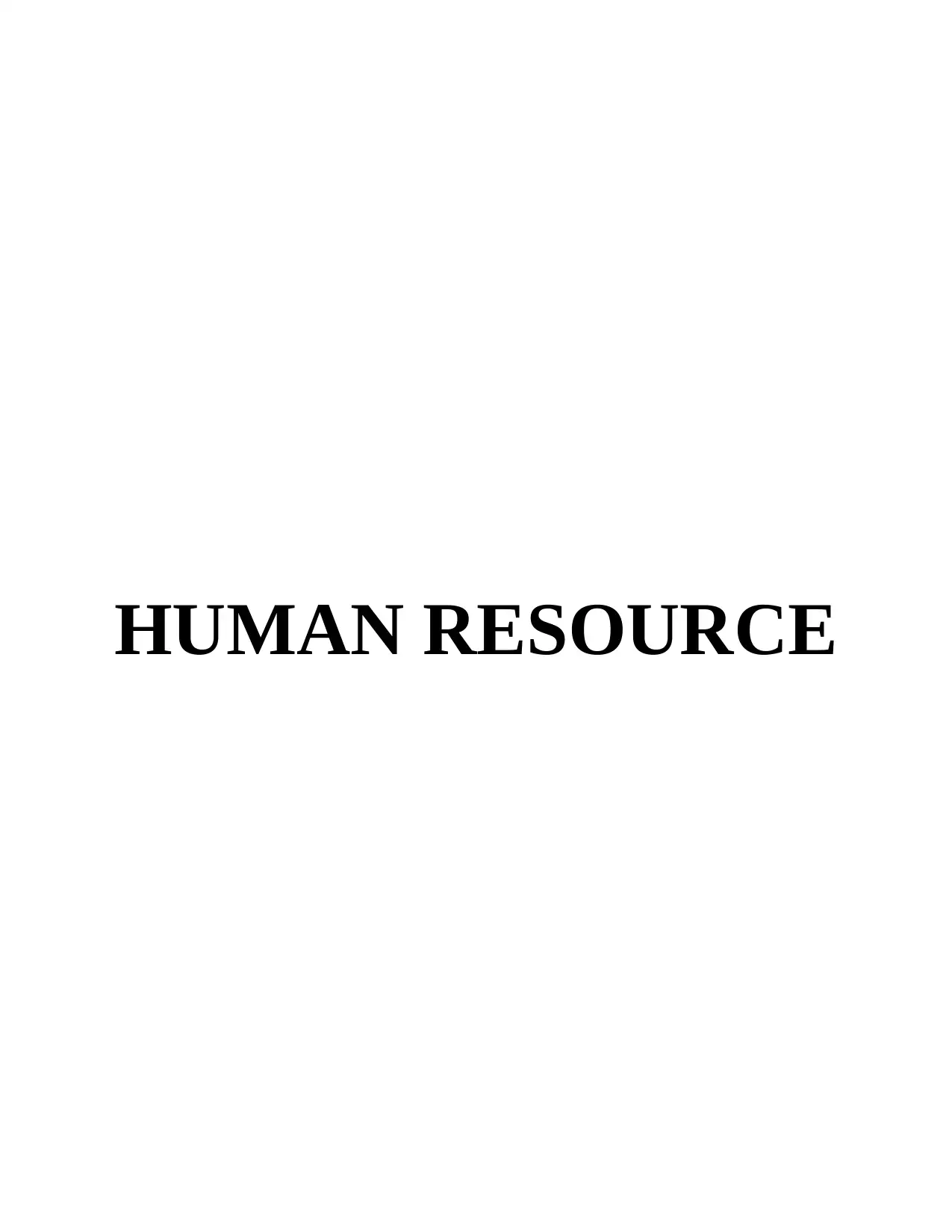
HUMAN RESOURCE
Paraphrase This Document
Need a fresh take? Get an instant paraphrase of this document with our AI Paraphraser
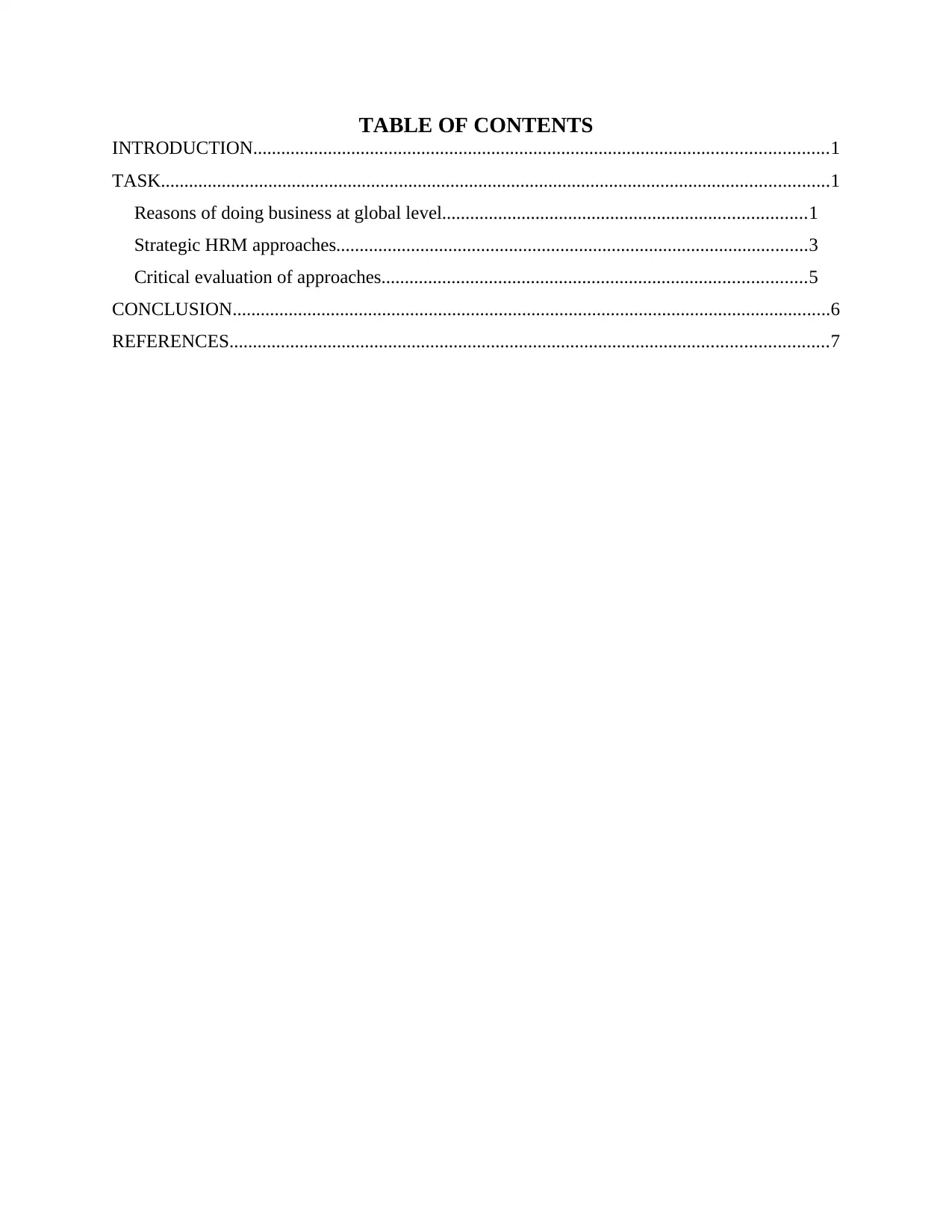
TABLE OF CONTENTS
INTRODUCTION...........................................................................................................................1
TASK...............................................................................................................................................1
Reasons of doing business at global level..............................................................................1
Strategic HRM approaches.....................................................................................................3
Critical evaluation of approaches...........................................................................................5
CONCLUSION................................................................................................................................6
REFERENCES................................................................................................................................7
INTRODUCTION...........................................................................................................................1
TASK...............................................................................................................................................1
Reasons of doing business at global level..............................................................................1
Strategic HRM approaches.....................................................................................................3
Critical evaluation of approaches...........................................................................................5
CONCLUSION................................................................................................................................6
REFERENCES................................................................................................................................7
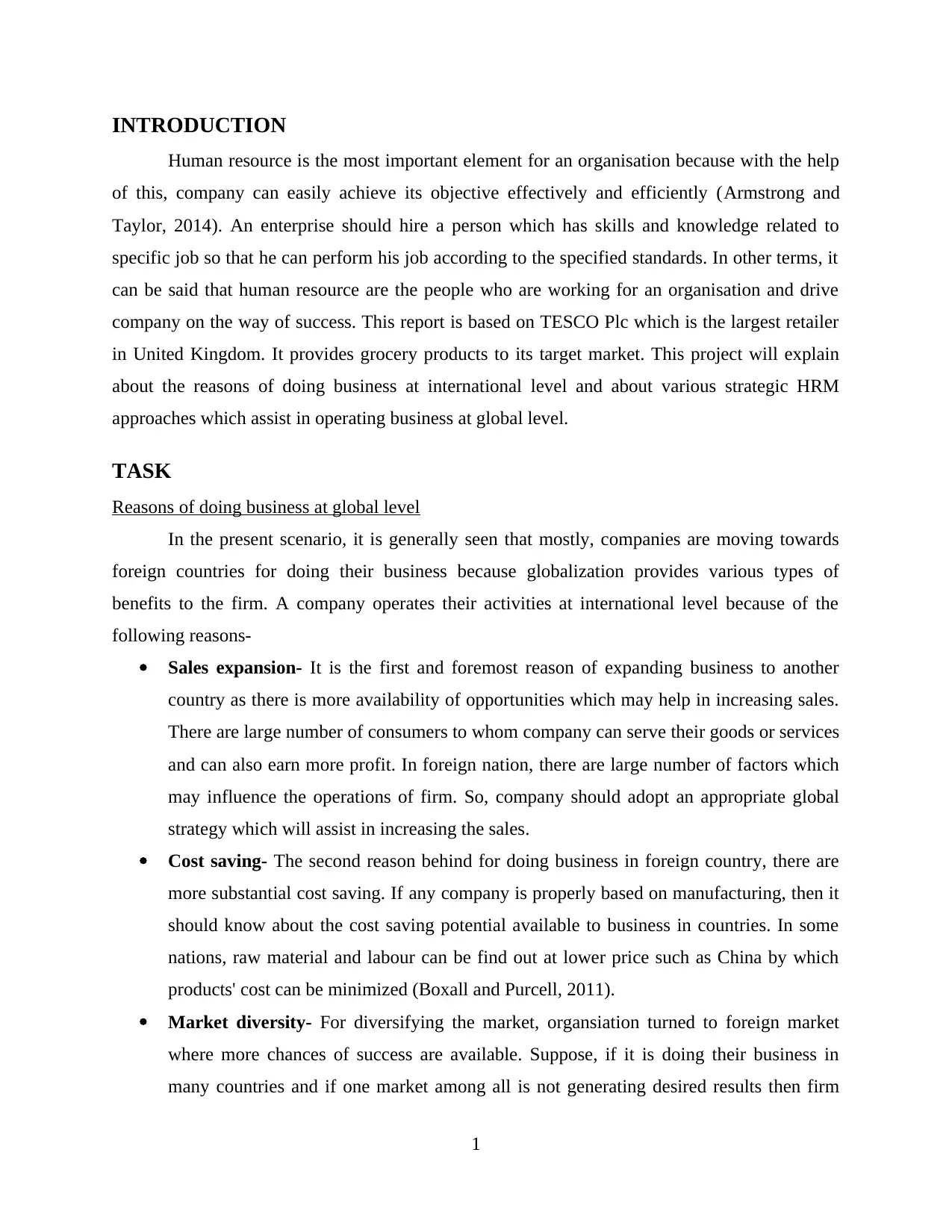
INTRODUCTION
Human resource is the most important element for an organisation because with the help
of this, company can easily achieve its objective effectively and efficiently (Armstrong and
Taylor, 2014). An enterprise should hire a person which has skills and knowledge related to
specific job so that he can perform his job according to the specified standards. In other terms, it
can be said that human resource are the people who are working for an organisation and drive
company on the way of success. This report is based on TESCO Plc which is the largest retailer
in United Kingdom. It provides grocery products to its target market. This project will explain
about the reasons of doing business at international level and about various strategic HRM
approaches which assist in operating business at global level.
TASK
Reasons of doing business at global level
In the present scenario, it is generally seen that mostly, companies are moving towards
foreign countries for doing their business because globalization provides various types of
benefits to the firm. A company operates their activities at international level because of the
following reasons-
Sales expansion- It is the first and foremost reason of expanding business to another
country as there is more availability of opportunities which may help in increasing sales.
There are large number of consumers to whom company can serve their goods or services
and can also earn more profit. In foreign nation, there are large number of factors which
may influence the operations of firm. So, company should adopt an appropriate global
strategy which will assist in increasing the sales.
Cost saving- The second reason behind for doing business in foreign country, there are
more substantial cost saving. If any company is properly based on manufacturing, then it
should know about the cost saving potential available to business in countries. In some
nations, raw material and labour can be find out at lower price such as China by which
products' cost can be minimized (Boxall and Purcell, 2011).
Market diversity- For diversifying the market, organsiation turned to foreign market
where more chances of success are available. Suppose, if it is doing their business in
many countries and if one market among all is not generating desired results then firm
1
Human resource is the most important element for an organisation because with the help
of this, company can easily achieve its objective effectively and efficiently (Armstrong and
Taylor, 2014). An enterprise should hire a person which has skills and knowledge related to
specific job so that he can perform his job according to the specified standards. In other terms, it
can be said that human resource are the people who are working for an organisation and drive
company on the way of success. This report is based on TESCO Plc which is the largest retailer
in United Kingdom. It provides grocery products to its target market. This project will explain
about the reasons of doing business at international level and about various strategic HRM
approaches which assist in operating business at global level.
TASK
Reasons of doing business at global level
In the present scenario, it is generally seen that mostly, companies are moving towards
foreign countries for doing their business because globalization provides various types of
benefits to the firm. A company operates their activities at international level because of the
following reasons-
Sales expansion- It is the first and foremost reason of expanding business to another
country as there is more availability of opportunities which may help in increasing sales.
There are large number of consumers to whom company can serve their goods or services
and can also earn more profit. In foreign nation, there are large number of factors which
may influence the operations of firm. So, company should adopt an appropriate global
strategy which will assist in increasing the sales.
Cost saving- The second reason behind for doing business in foreign country, there are
more substantial cost saving. If any company is properly based on manufacturing, then it
should know about the cost saving potential available to business in countries. In some
nations, raw material and labour can be find out at lower price such as China by which
products' cost can be minimized (Boxall and Purcell, 2011).
Market diversity- For diversifying the market, organsiation turned to foreign market
where more chances of success are available. Suppose, if it is doing their business in
many countries and if one market among all is not generating desired results then firm
1
⊘ This is a preview!⊘
Do you want full access?
Subscribe today to unlock all pages.

Trusted by 1+ million students worldwide
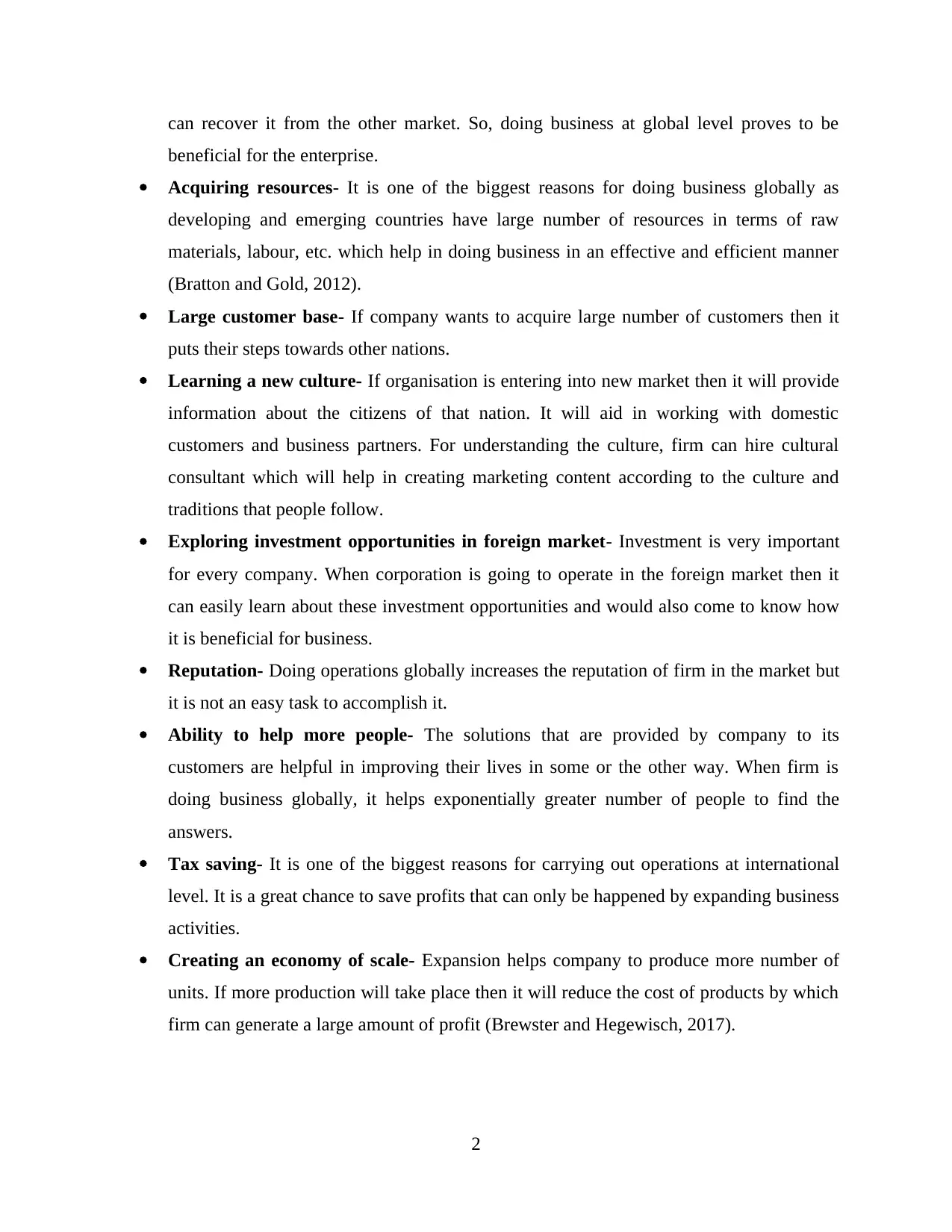
can recover it from the other market. So, doing business at global level proves to be
beneficial for the enterprise.
Acquiring resources- It is one of the biggest reasons for doing business globally as
developing and emerging countries have large number of resources in terms of raw
materials, labour, etc. which help in doing business in an effective and efficient manner
(Bratton and Gold, 2012).
Large customer base- If company wants to acquire large number of customers then it
puts their steps towards other nations.
Learning a new culture- If organisation is entering into new market then it will provide
information about the citizens of that nation. It will aid in working with domestic
customers and business partners. For understanding the culture, firm can hire cultural
consultant which will help in creating marketing content according to the culture and
traditions that people follow.
Exploring investment opportunities in foreign market- Investment is very important
for every company. When corporation is going to operate in the foreign market then it
can easily learn about these investment opportunities and would also come to know how
it is beneficial for business.
Reputation- Doing operations globally increases the reputation of firm in the market but
it is not an easy task to accomplish it.
Ability to help more people- The solutions that are provided by company to its
customers are helpful in improving their lives in some or the other way. When firm is
doing business globally, it helps exponentially greater number of people to find the
answers.
Tax saving- It is one of the biggest reasons for carrying out operations at international
level. It is a great chance to save profits that can only be happened by expanding business
activities.
Creating an economy of scale- Expansion helps company to produce more number of
units. If more production will take place then it will reduce the cost of products by which
firm can generate a large amount of profit (Brewster and Hegewisch, 2017).
2
beneficial for the enterprise.
Acquiring resources- It is one of the biggest reasons for doing business globally as
developing and emerging countries have large number of resources in terms of raw
materials, labour, etc. which help in doing business in an effective and efficient manner
(Bratton and Gold, 2012).
Large customer base- If company wants to acquire large number of customers then it
puts their steps towards other nations.
Learning a new culture- If organisation is entering into new market then it will provide
information about the citizens of that nation. It will aid in working with domestic
customers and business partners. For understanding the culture, firm can hire cultural
consultant which will help in creating marketing content according to the culture and
traditions that people follow.
Exploring investment opportunities in foreign market- Investment is very important
for every company. When corporation is going to operate in the foreign market then it
can easily learn about these investment opportunities and would also come to know how
it is beneficial for business.
Reputation- Doing operations globally increases the reputation of firm in the market but
it is not an easy task to accomplish it.
Ability to help more people- The solutions that are provided by company to its
customers are helpful in improving their lives in some or the other way. When firm is
doing business globally, it helps exponentially greater number of people to find the
answers.
Tax saving- It is one of the biggest reasons for carrying out operations at international
level. It is a great chance to save profits that can only be happened by expanding business
activities.
Creating an economy of scale- Expansion helps company to produce more number of
units. If more production will take place then it will reduce the cost of products by which
firm can generate a large amount of profit (Brewster and Hegewisch, 2017).
2
Paraphrase This Document
Need a fresh take? Get an instant paraphrase of this document with our AI Paraphraser
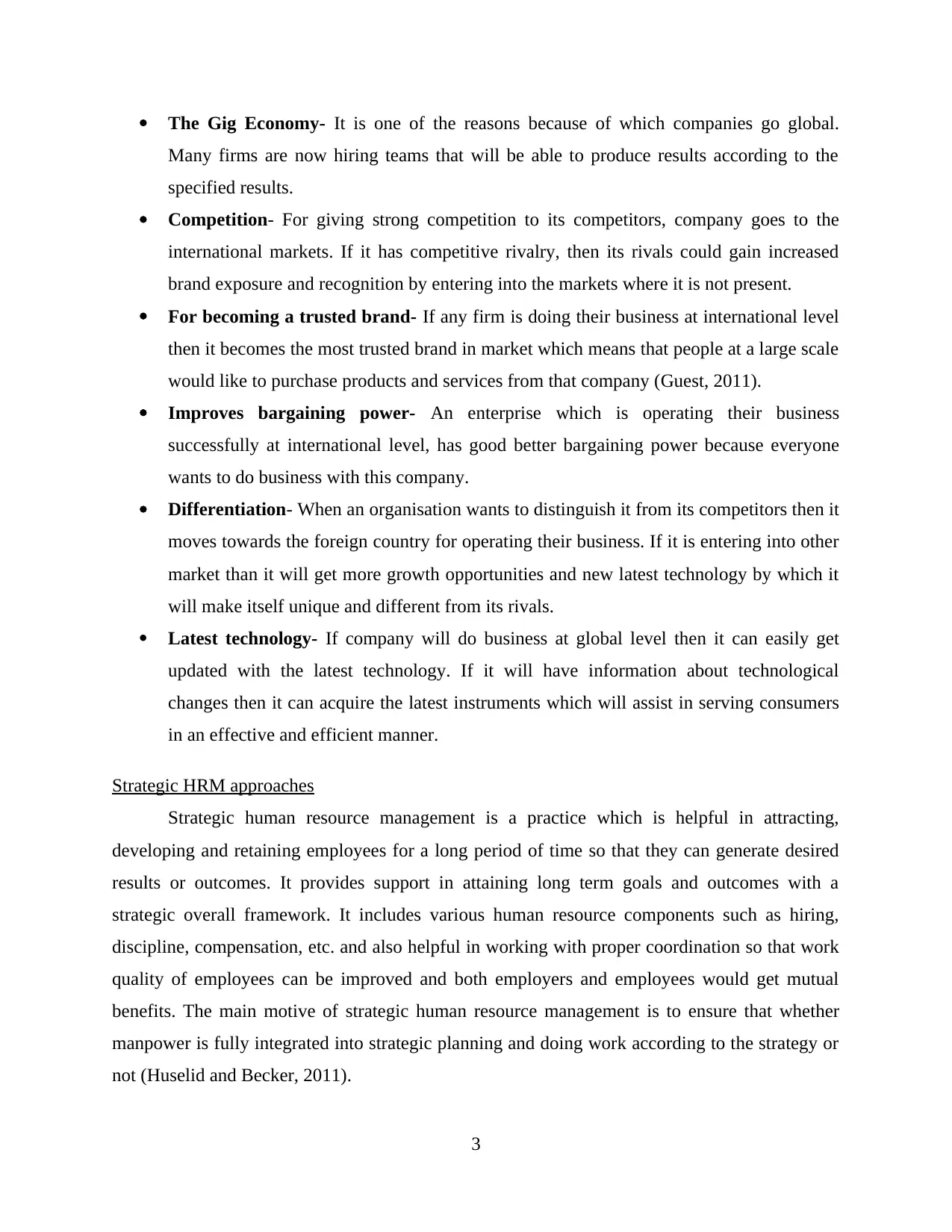
The Gig Economy- It is one of the reasons because of which companies go global.
Many firms are now hiring teams that will be able to produce results according to the
specified results.
Competition- For giving strong competition to its competitors, company goes to the
international markets. If it has competitive rivalry, then its rivals could gain increased
brand exposure and recognition by entering into the markets where it is not present.
For becoming a trusted brand- If any firm is doing their business at international level
then it becomes the most trusted brand in market which means that people at a large scale
would like to purchase products and services from that company (Guest, 2011).
Improves bargaining power- An enterprise which is operating their business
successfully at international level, has good better bargaining power because everyone
wants to do business with this company.
Differentiation- When an organisation wants to distinguish it from its competitors then it
moves towards the foreign country for operating their business. If it is entering into other
market than it will get more growth opportunities and new latest technology by which it
will make itself unique and different from its rivals.
Latest technology- If company will do business at global level then it can easily get
updated with the latest technology. If it will have information about technological
changes then it can acquire the latest instruments which will assist in serving consumers
in an effective and efficient manner.
Strategic HRM approaches
Strategic human resource management is a practice which is helpful in attracting,
developing and retaining employees for a long period of time so that they can generate desired
results or outcomes. It provides support in attaining long term goals and outcomes with a
strategic overall framework. It includes various human resource components such as hiring,
discipline, compensation, etc. and also helpful in working with proper coordination so that work
quality of employees can be improved and both employers and employees would get mutual
benefits. The main motive of strategic human resource management is to ensure that whether
manpower is fully integrated into strategic planning and doing work according to the strategy or
not (Huselid and Becker, 2011).
3
Many firms are now hiring teams that will be able to produce results according to the
specified results.
Competition- For giving strong competition to its competitors, company goes to the
international markets. If it has competitive rivalry, then its rivals could gain increased
brand exposure and recognition by entering into the markets where it is not present.
For becoming a trusted brand- If any firm is doing their business at international level
then it becomes the most trusted brand in market which means that people at a large scale
would like to purchase products and services from that company (Guest, 2011).
Improves bargaining power- An enterprise which is operating their business
successfully at international level, has good better bargaining power because everyone
wants to do business with this company.
Differentiation- When an organisation wants to distinguish it from its competitors then it
moves towards the foreign country for operating their business. If it is entering into other
market than it will get more growth opportunities and new latest technology by which it
will make itself unique and different from its rivals.
Latest technology- If company will do business at global level then it can easily get
updated with the latest technology. If it will have information about technological
changes then it can acquire the latest instruments which will assist in serving consumers
in an effective and efficient manner.
Strategic HRM approaches
Strategic human resource management is a practice which is helpful in attracting,
developing and retaining employees for a long period of time so that they can generate desired
results or outcomes. It provides support in attaining long term goals and outcomes with a
strategic overall framework. It includes various human resource components such as hiring,
discipline, compensation, etc. and also helpful in working with proper coordination so that work
quality of employees can be improved and both employers and employees would get mutual
benefits. The main motive of strategic human resource management is to ensure that whether
manpower is fully integrated into strategic planning and doing work according to the strategy or
not (Huselid and Becker, 2011).
3
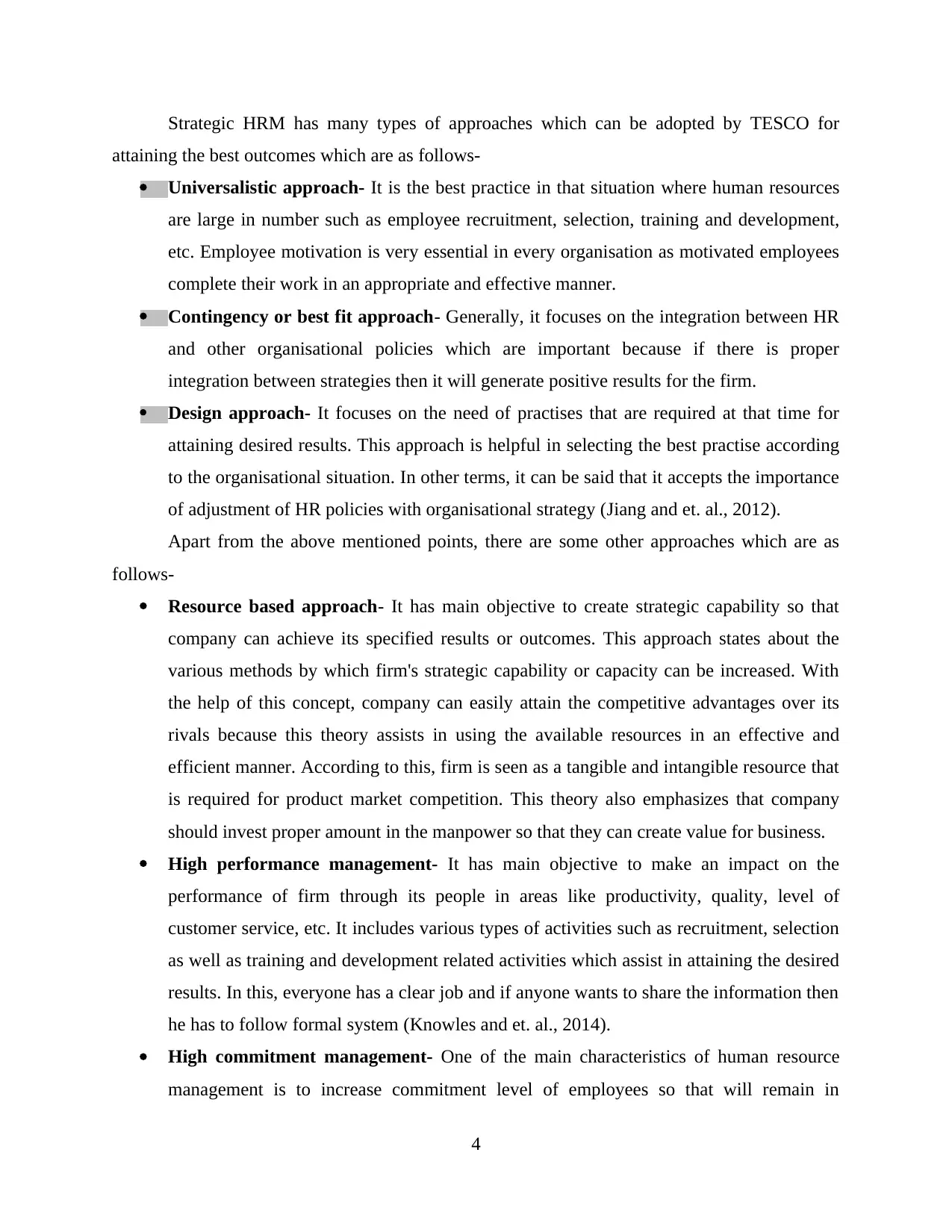
Strategic HRM has many types of approaches which can be adopted by TESCO for
attaining the best outcomes which are as follows-
Universalistic approach- It is the best practice in that situation where human resources
are large in number such as employee recruitment, selection, training and development,
etc. Employee motivation is very essential in every organisation as motivated employees
complete their work in an appropriate and effective manner.
Contingency or best fit approach- Generally, it focuses on the integration between HR
and other organisational policies which are important because if there is proper
integration between strategies then it will generate positive results for the firm.
Design approach- It focuses on the need of practises that are required at that time for
attaining desired results. This approach is helpful in selecting the best practise according
to the organisational situation. In other terms, it can be said that it accepts the importance
of adjustment of HR policies with organisational strategy (Jiang and et. al., 2012).
Apart from the above mentioned points, there are some other approaches which are as
follows-
Resource based approach- It has main objective to create strategic capability so that
company can achieve its specified results or outcomes. This approach states about the
various methods by which firm's strategic capability or capacity can be increased. With
the help of this concept, company can easily attain the competitive advantages over its
rivals because this theory assists in using the available resources in an effective and
efficient manner. According to this, firm is seen as a tangible and intangible resource that
is required for product market competition. This theory also emphasizes that company
should invest proper amount in the manpower so that they can create value for business.
High performance management- It has main objective to make an impact on the
performance of firm through its people in areas like productivity, quality, level of
customer service, etc. It includes various types of activities such as recruitment, selection
as well as training and development related activities which assist in attaining the desired
results. In this, everyone has a clear job and if anyone wants to share the information then
he has to follow formal system (Knowles and et. al., 2014).
High commitment management- One of the main characteristics of human resource
management is to increase commitment level of employees so that will remain in
4
attaining the best outcomes which are as follows-
Universalistic approach- It is the best practice in that situation where human resources
are large in number such as employee recruitment, selection, training and development,
etc. Employee motivation is very essential in every organisation as motivated employees
complete their work in an appropriate and effective manner.
Contingency or best fit approach- Generally, it focuses on the integration between HR
and other organisational policies which are important because if there is proper
integration between strategies then it will generate positive results for the firm.
Design approach- It focuses on the need of practises that are required at that time for
attaining desired results. This approach is helpful in selecting the best practise according
to the organisational situation. In other terms, it can be said that it accepts the importance
of adjustment of HR policies with organisational strategy (Jiang and et. al., 2012).
Apart from the above mentioned points, there are some other approaches which are as
follows-
Resource based approach- It has main objective to create strategic capability so that
company can achieve its specified results or outcomes. This approach states about the
various methods by which firm's strategic capability or capacity can be increased. With
the help of this concept, company can easily attain the competitive advantages over its
rivals because this theory assists in using the available resources in an effective and
efficient manner. According to this, firm is seen as a tangible and intangible resource that
is required for product market competition. This theory also emphasizes that company
should invest proper amount in the manpower so that they can create value for business.
High performance management- It has main objective to make an impact on the
performance of firm through its people in areas like productivity, quality, level of
customer service, etc. It includes various types of activities such as recruitment, selection
as well as training and development related activities which assist in attaining the desired
results. In this, everyone has a clear job and if anyone wants to share the information then
he has to follow formal system (Knowles and et. al., 2014).
High commitment management- One of the main characteristics of human resource
management is to increase commitment level of employees so that will remain in
4
⊘ This is a preview!⊘
Do you want full access?
Subscribe today to unlock all pages.

Trusted by 1+ million students worldwide
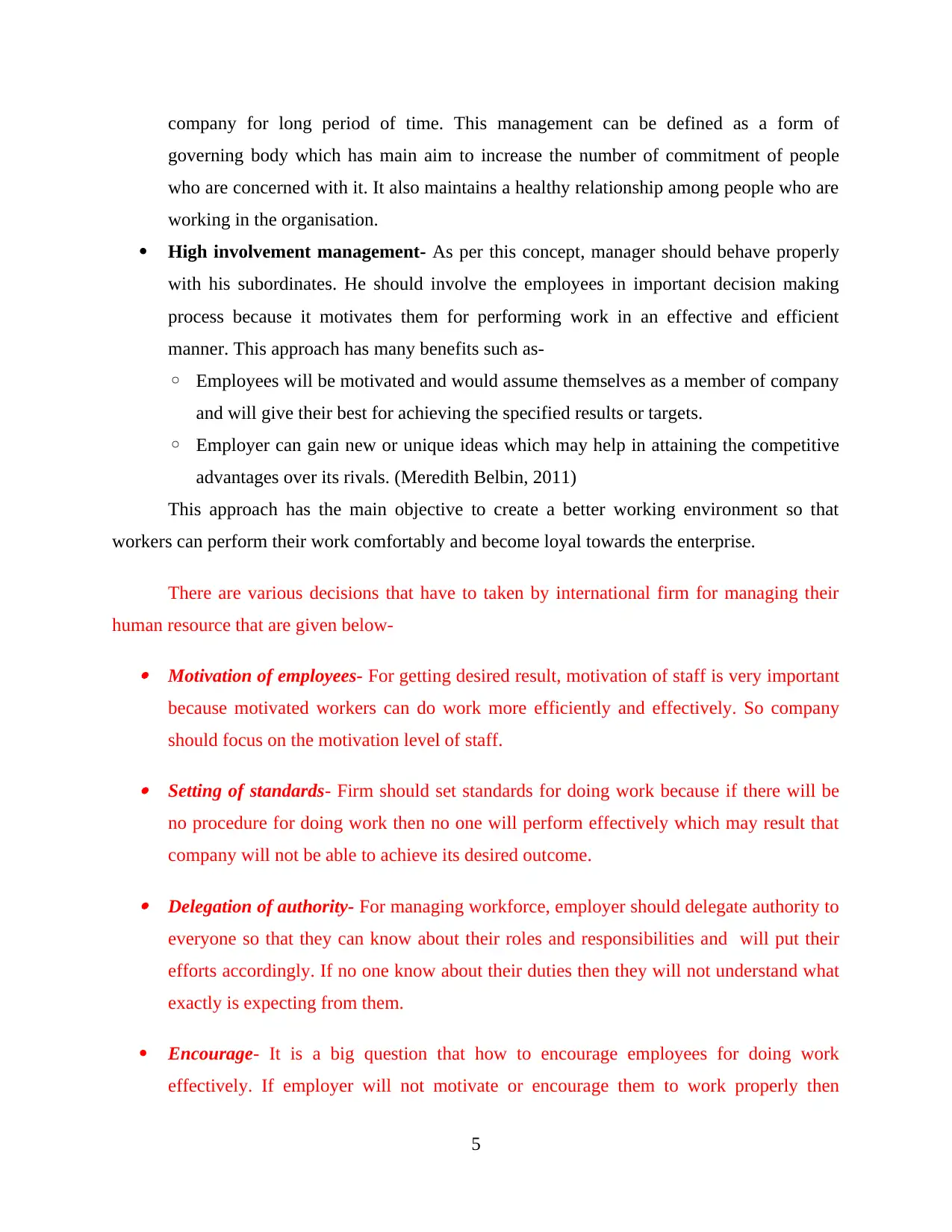
company for long period of time. This management can be defined as a form of
governing body which has main aim to increase the number of commitment of people
who are concerned with it. It also maintains a healthy relationship among people who are
working in the organisation.
High involvement management- As per this concept, manager should behave properly
with his subordinates. He should involve the employees in important decision making
process because it motivates them for performing work in an effective and efficient
manner. This approach has many benefits such as-
◦ Employees will be motivated and would assume themselves as a member of company
and will give their best for achieving the specified results or targets.
◦ Employer can gain new or unique ideas which may help in attaining the competitive
advantages over its rivals. (Meredith Belbin, 2011)
This approach has the main objective to create a better working environment so that
workers can perform their work comfortably and become loyal towards the enterprise.
There are various decisions that have to taken by international firm for managing their
human resource that are given below-
Motivation of employees- For getting desired result, motivation of staff is very important
because motivated workers can do work more efficiently and effectively. So company
should focus on the motivation level of staff.
Setting of standards- Firm should set standards for doing work because if there will be
no procedure for doing work then no one will perform effectively which may result that
company will not be able to achieve its desired outcome.
Delegation of authority- For managing workforce, employer should delegate authority to
everyone so that they can know about their roles and responsibilities and will put their
efforts accordingly. If no one know about their duties then they will not understand what
exactly is expecting from them.
Encourage- It is a big question that how to encourage employees for doing work
effectively. If employer will not motivate or encourage them to work properly then
5
governing body which has main aim to increase the number of commitment of people
who are concerned with it. It also maintains a healthy relationship among people who are
working in the organisation.
High involvement management- As per this concept, manager should behave properly
with his subordinates. He should involve the employees in important decision making
process because it motivates them for performing work in an effective and efficient
manner. This approach has many benefits such as-
◦ Employees will be motivated and would assume themselves as a member of company
and will give their best for achieving the specified results or targets.
◦ Employer can gain new or unique ideas which may help in attaining the competitive
advantages over its rivals. (Meredith Belbin, 2011)
This approach has the main objective to create a better working environment so that
workers can perform their work comfortably and become loyal towards the enterprise.
There are various decisions that have to taken by international firm for managing their
human resource that are given below-
Motivation of employees- For getting desired result, motivation of staff is very important
because motivated workers can do work more efficiently and effectively. So company
should focus on the motivation level of staff.
Setting of standards- Firm should set standards for doing work because if there will be
no procedure for doing work then no one will perform effectively which may result that
company will not be able to achieve its desired outcome.
Delegation of authority- For managing workforce, employer should delegate authority to
everyone so that they can know about their roles and responsibilities and will put their
efforts accordingly. If no one know about their duties then they will not understand what
exactly is expecting from them.
Encourage- It is a big question that how to encourage employees for doing work
effectively. If employer will not motivate or encourage them to work properly then
5
Paraphrase This Document
Need a fresh take? Get an instant paraphrase of this document with our AI Paraphraser
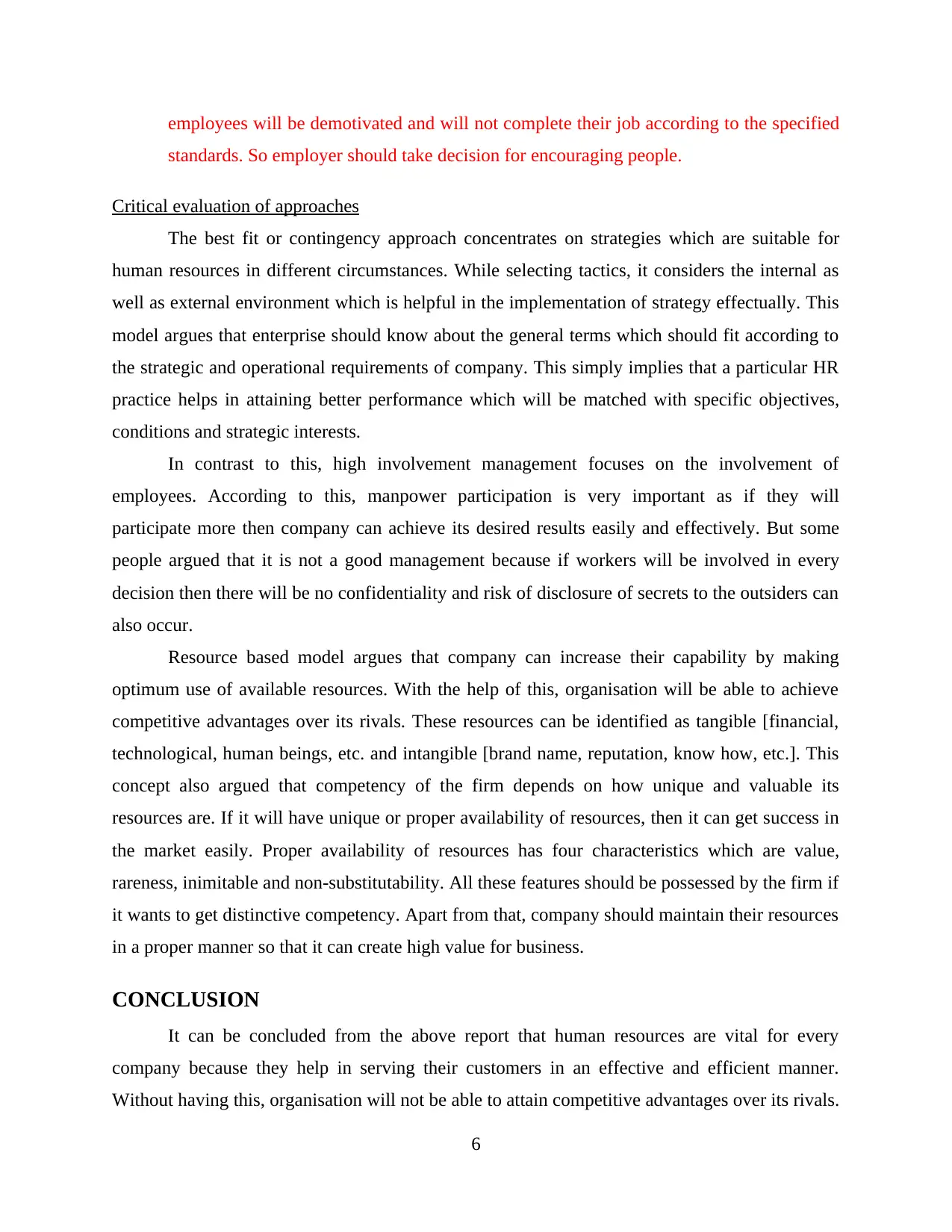
employees will be demotivated and will not complete their job according to the specified
standards. So employer should take decision for encouraging people.
Critical evaluation of approaches
The best fit or contingency approach concentrates on strategies which are suitable for
human resources in different circumstances. While selecting tactics, it considers the internal as
well as external environment which is helpful in the implementation of strategy effectually. This
model argues that enterprise should know about the general terms which should fit according to
the strategic and operational requirements of company. This simply implies that a particular HR
practice helps in attaining better performance which will be matched with specific objectives,
conditions and strategic interests.
In contrast to this, high involvement management focuses on the involvement of
employees. According to this, manpower participation is very important as if they will
participate more then company can achieve its desired results easily and effectively. But some
people argued that it is not a good management because if workers will be involved in every
decision then there will be no confidentiality and risk of disclosure of secrets to the outsiders can
also occur.
Resource based model argues that company can increase their capability by making
optimum use of available resources. With the help of this, organisation will be able to achieve
competitive advantages over its rivals. These resources can be identified as tangible [financial,
technological, human beings, etc. and intangible [brand name, reputation, know how, etc.]. This
concept also argued that competency of the firm depends on how unique and valuable its
resources are. If it will have unique or proper availability of resources, then it can get success in
the market easily. Proper availability of resources has four characteristics which are value,
rareness, inimitable and non-substitutability. All these features should be possessed by the firm if
it wants to get distinctive competency. Apart from that, company should maintain their resources
in a proper manner so that it can create high value for business.
CONCLUSION
It can be concluded from the above report that human resources are vital for every
company because they help in serving their customers in an effective and efficient manner.
Without having this, organisation will not be able to attain competitive advantages over its rivals.
6
standards. So employer should take decision for encouraging people.
Critical evaluation of approaches
The best fit or contingency approach concentrates on strategies which are suitable for
human resources in different circumstances. While selecting tactics, it considers the internal as
well as external environment which is helpful in the implementation of strategy effectually. This
model argues that enterprise should know about the general terms which should fit according to
the strategic and operational requirements of company. This simply implies that a particular HR
practice helps in attaining better performance which will be matched with specific objectives,
conditions and strategic interests.
In contrast to this, high involvement management focuses on the involvement of
employees. According to this, manpower participation is very important as if they will
participate more then company can achieve its desired results easily and effectively. But some
people argued that it is not a good management because if workers will be involved in every
decision then there will be no confidentiality and risk of disclosure of secrets to the outsiders can
also occur.
Resource based model argues that company can increase their capability by making
optimum use of available resources. With the help of this, organisation will be able to achieve
competitive advantages over its rivals. These resources can be identified as tangible [financial,
technological, human beings, etc. and intangible [brand name, reputation, know how, etc.]. This
concept also argued that competency of the firm depends on how unique and valuable its
resources are. If it will have unique or proper availability of resources, then it can get success in
the market easily. Proper availability of resources has four characteristics which are value,
rareness, inimitable and non-substitutability. All these features should be possessed by the firm if
it wants to get distinctive competency. Apart from that, company should maintain their resources
in a proper manner so that it can create high value for business.
CONCLUSION
It can be concluded from the above report that human resources are vital for every
company because they help in serving their customers in an effective and efficient manner.
Without having this, organisation will not be able to attain competitive advantages over its rivals.
6
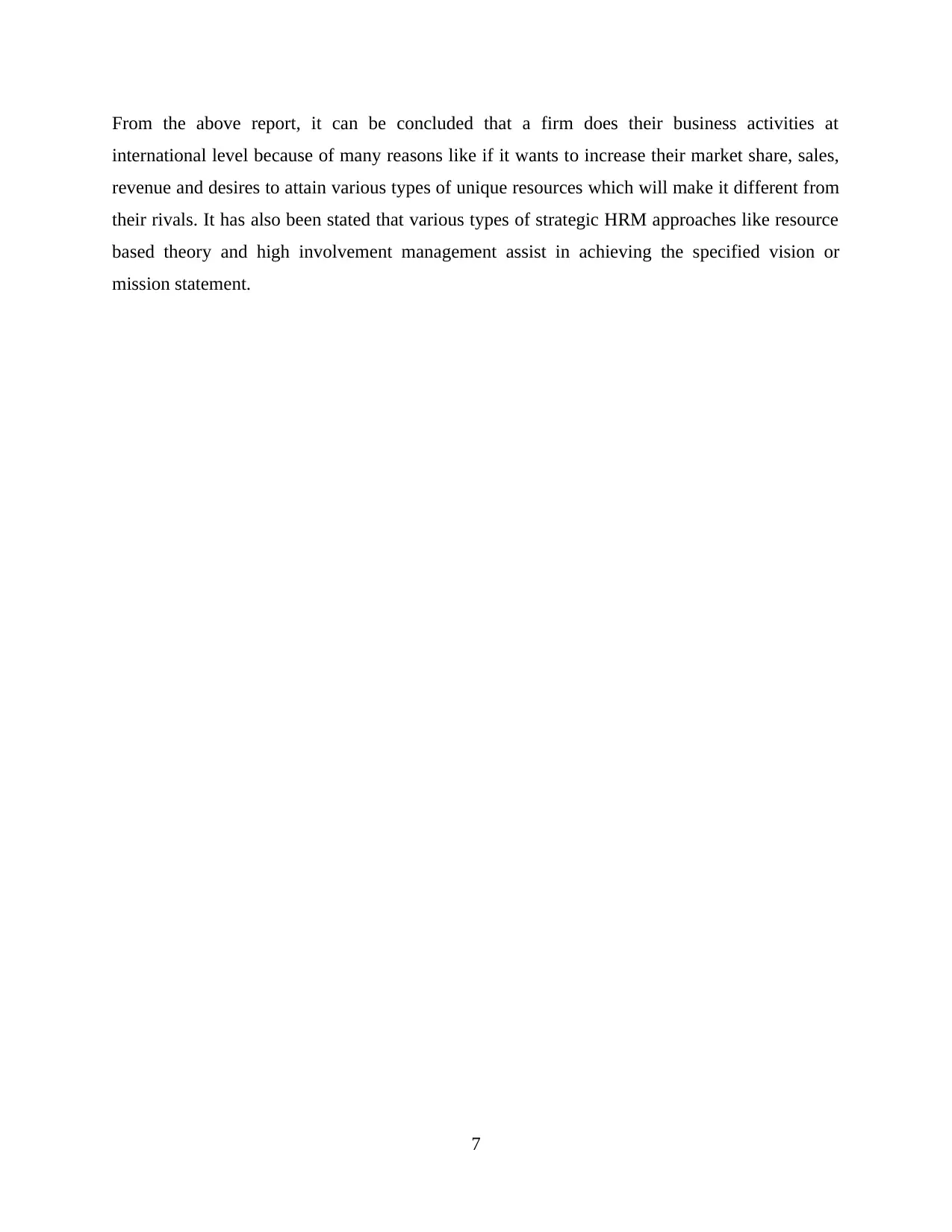
From the above report, it can be concluded that a firm does their business activities at
international level because of many reasons like if it wants to increase their market share, sales,
revenue and desires to attain various types of unique resources which will make it different from
their rivals. It has also been stated that various types of strategic HRM approaches like resource
based theory and high involvement management assist in achieving the specified vision or
mission statement.
7
international level because of many reasons like if it wants to increase their market share, sales,
revenue and desires to attain various types of unique resources which will make it different from
their rivals. It has also been stated that various types of strategic HRM approaches like resource
based theory and high involvement management assist in achieving the specified vision or
mission statement.
7
⊘ This is a preview!⊘
Do you want full access?
Subscribe today to unlock all pages.

Trusted by 1+ million students worldwide
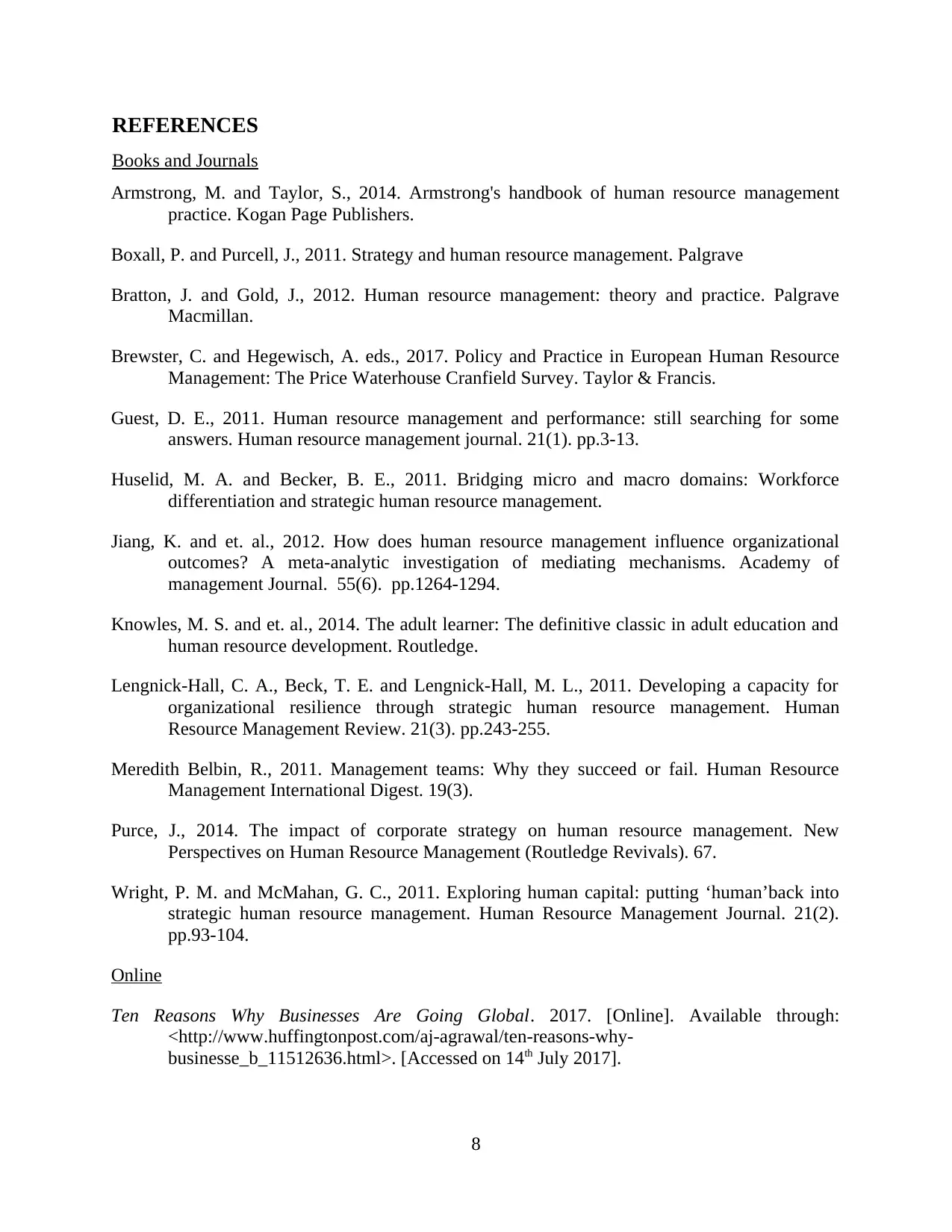
REFERENCES
Books and Journals
Armstrong, M. and Taylor, S., 2014. Armstrong's handbook of human resource management
practice. Kogan Page Publishers.
Boxall, P. and Purcell, J., 2011. Strategy and human resource management. Palgrave
Bratton, J. and Gold, J., 2012. Human resource management: theory and practice. Palgrave
Macmillan.
Brewster, C. and Hegewisch, A. eds., 2017. Policy and Practice in European Human Resource
Management: The Price Waterhouse Cranfield Survey. Taylor & Francis.
Guest, D. E., 2011. Human resource management and performance: still searching for some
answers. Human resource management journal. 21(1). pp.3-13.
Huselid, M. A. and Becker, B. E., 2011. Bridging micro and macro domains: Workforce
differentiation and strategic human resource management.
Jiang, K. and et. al., 2012. How does human resource management influence organizational
outcomes? A meta-analytic investigation of mediating mechanisms. Academy of
management Journal. 55(6). pp.1264-1294.
Knowles, M. S. and et. al., 2014. The adult learner: The definitive classic in adult education and
human resource development. Routledge.
Lengnick-Hall, C. A., Beck, T. E. and Lengnick-Hall, M. L., 2011. Developing a capacity for
organizational resilience through strategic human resource management. Human
Resource Management Review. 21(3). pp.243-255.
Meredith Belbin, R., 2011. Management teams: Why they succeed or fail. Human Resource
Management International Digest. 19(3).
Purce, J., 2014. The impact of corporate strategy on human resource management. New
Perspectives on Human Resource Management (Routledge Revivals). 67.
Wright, P. M. and McMahan, G. C., 2011. Exploring human capital: putting ‘human’back into
strategic human resource management. Human Resource Management Journal. 21(2).
pp.93-104.
Online
Ten Reasons Why Businesses Are Going Global. 2017. [Online]. Available through:
<http://www.huffingtonpost.com/aj-agrawal/ten-reasons-why-
businesse_b_11512636.html>. [Accessed on 14th July 2017].
8
Books and Journals
Armstrong, M. and Taylor, S., 2014. Armstrong's handbook of human resource management
practice. Kogan Page Publishers.
Boxall, P. and Purcell, J., 2011. Strategy and human resource management. Palgrave
Bratton, J. and Gold, J., 2012. Human resource management: theory and practice. Palgrave
Macmillan.
Brewster, C. and Hegewisch, A. eds., 2017. Policy and Practice in European Human Resource
Management: The Price Waterhouse Cranfield Survey. Taylor & Francis.
Guest, D. E., 2011. Human resource management and performance: still searching for some
answers. Human resource management journal. 21(1). pp.3-13.
Huselid, M. A. and Becker, B. E., 2011. Bridging micro and macro domains: Workforce
differentiation and strategic human resource management.
Jiang, K. and et. al., 2012. How does human resource management influence organizational
outcomes? A meta-analytic investigation of mediating mechanisms. Academy of
management Journal. 55(6). pp.1264-1294.
Knowles, M. S. and et. al., 2014. The adult learner: The definitive classic in adult education and
human resource development. Routledge.
Lengnick-Hall, C. A., Beck, T. E. and Lengnick-Hall, M. L., 2011. Developing a capacity for
organizational resilience through strategic human resource management. Human
Resource Management Review. 21(3). pp.243-255.
Meredith Belbin, R., 2011. Management teams: Why they succeed or fail. Human Resource
Management International Digest. 19(3).
Purce, J., 2014. The impact of corporate strategy on human resource management. New
Perspectives on Human Resource Management (Routledge Revivals). 67.
Wright, P. M. and McMahan, G. C., 2011. Exploring human capital: putting ‘human’back into
strategic human resource management. Human Resource Management Journal. 21(2).
pp.93-104.
Online
Ten Reasons Why Businesses Are Going Global. 2017. [Online]. Available through:
<http://www.huffingtonpost.com/aj-agrawal/ten-reasons-why-
businesse_b_11512636.html>. [Accessed on 14th July 2017].
8
1 out of 10
Related Documents
Your All-in-One AI-Powered Toolkit for Academic Success.
+13062052269
info@desklib.com
Available 24*7 on WhatsApp / Email
![[object Object]](/_next/static/media/star-bottom.7253800d.svg)
Unlock your academic potential
Copyright © 2020–2025 A2Z Services. All Rights Reserved. Developed and managed by ZUCOL.




